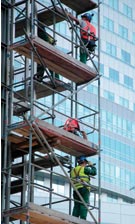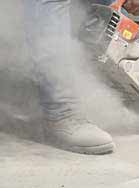The "supersport" motorcycles are extremely popular, with registrations up 83 percent in 2005 from 2000. Their drivers have a worrisome death rate.
The U.S. Labor Department, U.S. Chamber of Commerce, National Chicken Council, and American Meat Institute filed amicus briefs in the appeal.
This will be the latest hearing on Capitol Hill to ask why some responders and recovery workers developed respiratory illnesses.
The second annual event is intended to help employers of about 4,000 laborers who move from Arizona to California to harvest crops.
Safety committee chairmen in both houses of Congress want answers from MSHA about the Crandall Canyon mine disaster Aug. 6, which claimed nine lives in all. MSHA has already appointed its own investigative team.

A disgruntled field employee (in front of a crew of scowling, arms-crossed guys) tossed a set of dirty, beat-up safety glasses at me in disgust. "They're scratched, this no good piece of #@*!" he exclaimed. The explanation: A piece of debris or gravel had been slung while on a maintenance job, deeply scratching the lens.
File a notice by Oct. 1 if you want to testify at the hearing, where opponents will challenge the plan to recognize "good design standards."
The investigation was opened at the request of Tillotson Corp., d/b/a Best Manufacturing, which is being acquired by Showa, a Japanese glove maker.

AS the November 2008 deadline approaches for compliance with the Federal Highway Administration's new high-visibility mandate, it is critical that individuals in affected industries know how they will be affected by the changes to come. Affected occupations include road workers and first responders exposed to the low-visibility hazards of moving vehicular traffic.

YOU buy and use fall protection harnesses, lanyards, rope grabs, lifelines, retractables, and other equipment every day. Each item is labeled, ensuring that it conforms to ANSI specifications and OSHA regulations. These product certifications give you confidence and peace of mind.

I read the preceding statement while performing a simulated OSHA inspection. Most fall-related injuries result from the lack of fall protection. Additional injuries occur from improper use of fall protection—utilizing a body belt instead of a full body harness, improper use of lanyards, or utilizing an inadequate anchorage point.

You may not realize that a worker's shoes make him or her more productive, but Tom Votel makes a good case below for the proposition. And if good footwear and inserts can boost productivity, it stands to reason that poor footwear can harm it. Votel, President and CEO of Ergodyne discussed footwear's role in worker productivity during an April 13, 2007, conversation with Occupational Health & Safety's editor. Excerpts from the conversation follow.
Without wearing the necessary protective equipment, more injuries and fatalities will occur on the job. This is something Jerry Bach, vice president of Sacramento, Calif.-based Safety Center, Inc., will not tolerate. Wearing personal protective equipment is not only common sense that will keep you alive and safe, it also cuts down on worker's compensation claims, insurance premiums, and personal injury lawsuits for which employers must pay the price.
OUR hands are two the most valuable and widely used tools in the workplace. Proper glove selection is essential in protecting these tools from on-the-job hazards. All too often, workers are faced with a very limited understanding of why hand protection is needed or even how to select a glove properly for their application. The wrong glove often is selected for the job task, which risks injury to the worker or a loss in productivity.

FOR decades, studies in the workplace have shown hearing protectors to be underperformers: Real-world attenuation (noise blocking) is less than the published Noise Reduction Rating (NRR) for many workers. Studies like these have spawned a variety of de-rating schemes for hearing protectors that are often misunderstood or misapplied, such as the 50 percent OSHA de-rating or the NIOSH 75/50/30 percent de-rating for ear muffs, formable ear plugs, and pre-molded ear plugs, respectively.
DURING the past half century, technology has improved virtually every aspect of human life. However, during this period, not much has changed in the world of personal protective equipment. For hearing safety, workers may choose either ear plugs that are inserted into the ear or ear muffs that cover the ears.

WHEN Hurricane Katrina slammed ashore in 2005, it helped drive home the fact that intense hurricanes are becoming a constant concern for residents along the Gulf Coast and Florida coastal regions. While no hurricane touched the U.S. coastline in 2006, that unusual respite is not likely to be repeated this year, according to a forecast issued by Colorado State University's forecasting team. The El Nino weather conditions that led to a quiet Atlantic hurricane season in 2006 will probably dissipate by summer, leading to above-average hurricane activity for 2007.

PICTURE, if you will, the new Safety Director at a sheet metal fabricator in the early 1990s. Fresh out of college with a degree in Safety Engineering and a desire to work in industry, he sincerely wants to "help" promote the idea of a safe workplace. He wants to "make a difference."
On the first day of his new job, he is confronted with an accident that results in a severe laceration of a worker's hand. A hospital trip is involved. This one will definitely go down as a Lost Time Accident. There is grumbling about a potential lawsuit.

ON-THE-JOB injuries cost employers nearly $1 billion per week in payments to injured employees and their medical care providers, according to Boston-based Liberty Mutual, the leading private provider of worker's compensation insurance in the United States. Where do the injuries come from? Falls are one of the leading causes of deaths in the workplace, according to the National Safety Council.

MORE than 30 million workers are exposed to hazardous noise levels in the workplace. It is estimated that costs just for work-related hearing disability exceed $242 million annually! The National Institute for Occupational Safety and Health reports hearing loss is one of its priority areas for research for this century. Noise-induced hearing loss is the most common way for a person to lose hearing; one out of every 10 Americans suffers a loss of hearing severe enough for it to affect daily conversation and how normal speech is understood.